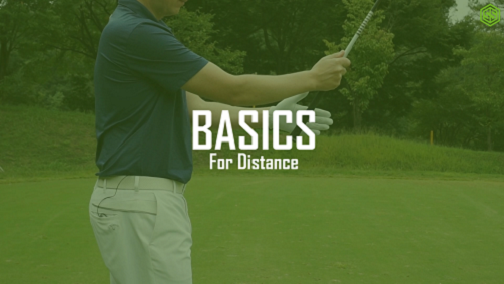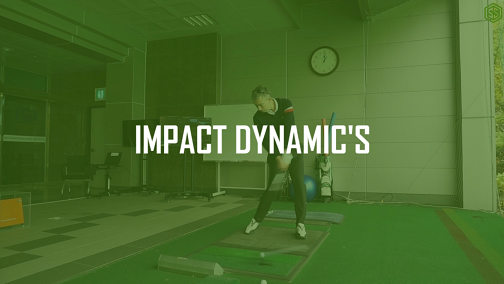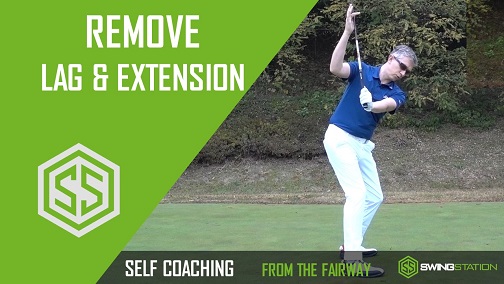Video lesson – Pressure Transfer
How to transfer pressure
Hi. Robin here with a summary of a lesson I’ve just given. This girl’s a good player but she struggles with her transition, not getting her weight back to her left foot, as you can see here clearly if I just put a line up from her left ankle. She doesn’t really get her left hip back over her left foot, hangs back slightly. That can cause her to flip the club and miss some shots to the left. Now, this is a little bit interesting, maybe complicated. I don’t know. You might get this concept, what I’m trying to explain straight away. You might not, but try to follow. I think there’s something to be learned here for anybody who’s really wanting to improve their transition or been struggling for a long time with improving their transition. They’re looking for a new direction, a new concept of how they can get that transition they’ve been searching for; get the pressure to the left foot and get a more solid golf shot.
The point here is that sometimes what we see here on a 2D image from a camera is not really what’s going on in the swing. You can see with this player, she’s moved her hips quite a bit to the right in the back swing. The left hip moves off that line, head moves quite a lot to the right. What we measure on our balance system, this tells us that she’s actually only got 61% weight on her right foot at the top. That’s really below average. I could show you examples of players who look a lot more central than this but have more weight on their right foot, more pressure on their right foot. It’s not just about how much you’re moving, in this fashion, sort of left and right which determines where the pressure is in your feet. It’s a lot to do with the way you’re rotating, a lot to do with the motion of your arms, the weight of your arms swinging around your body, the weight of the club head swinging around your body.
Now, I’m trying not to get technical. Really, all I told this player today was that I wanted her to feel like she was rotating the back swing rather than swaying, so she’s staying a little more central over the ball. But, when in rotating, for a split second, if she can feel like the pressure comes slightly off her left heel for a split second, that’s going to give us more pressure into the right foot and then lead to a more natural transition where the left hip sits back over the left foot. Weight moves to the left, stops her hanging back. You can see instantly an improvement, and that’s something she wasn’t really thinking about. It was just from a slightly different pivot in the back swing, and that reduction of pressure under the left heel for the split second. Something to learn here is that a good back swing, one where the pressure is moving correctly, you shouldn’t really be able to stop at the top of the backswing.
The only way she can do that is to keep in constant motion. So even though she looks a lot more central during the backswing, in this 2D imagine, actually when we measured her we were up to 80% pressure on her right foot at the top of the backswing. And then as a result of this 80% pressure on the right foot, reduction of pressure under the left foot, through impact we were now up to 70% of weight on her left foot where before we were only at 50/50 right foot to left foot, so huge difference in the way that she was moving through the ball.
So what can we learn from this? Number one, standing and looking at your swing in a mirror, and stopping at the top of the backswing can sometimes not be the best thing, because in a good golf swing, you really shouldn’t be able to stop at the top. The pressure reduction in the left foot is something that happens as a split second, and you’ve got to be in motion to be able to do that, so I always like to see people making full, one piece practice swings, not stopping in different positions. Number 2, you can rotate, you don’t have to sway to transfer your weight. Focus on keeping yourself rotating during the swing. Rotating hips, rotating shoulders, letting your arms swing around your body, and just try to feel that there’s a reduction of pressure under your left foot for a split second.
Many good players I see on the balance lab have very little pressure under their left heel at the top of the backswing. If you look at someone like Roy McIlroy these days, you zoom in on his left foot, his left heel actually comes slightly up. This might be something you really have to look carefully to see it, or it might be something you can feel but other players can’t see it. But you’re sure if you’re rotating, and the pressure’s reducing underneath your left foot, you’re really sure to be improving your transitions, it’s almost something you can’t stop, that constant motion, the foot replanting itself on the ground, takes care of the transition, takes care of the weight shift back to your left foot, and hopefully you can get some improvement without really having to think about things too much. So I hope that’s a lesson which is helping some players out there. Thanks for watching.




